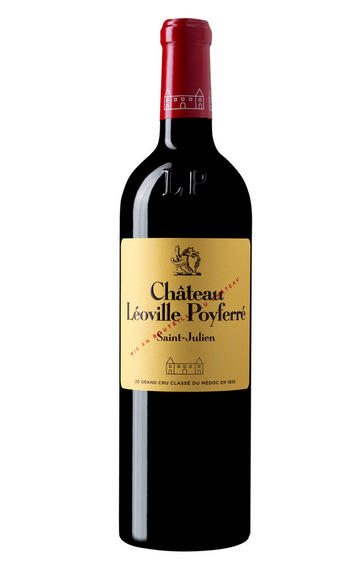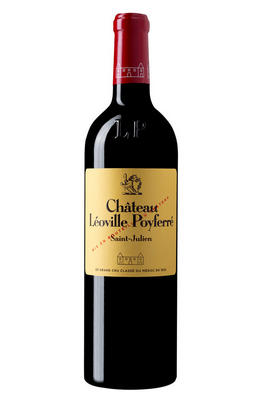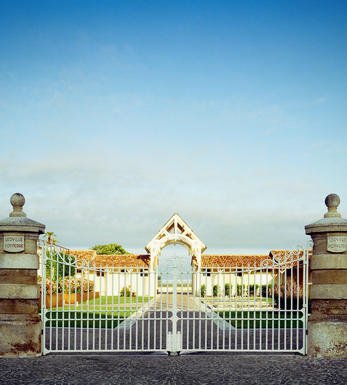
2022 Château Léoville Poyferré, St Julien, Bordeaux

Critics reviews
The 2022 Léoville Poyferré was picked from 8 to 28 September at 33.4hL/ha and matured in 80% new oak. It has a high IPT of 93 and 14.4% alcohol (half a degree less than the 2018). It is quintessentially LP on the nose, with those extravagant and sensual black and blueberry fruit intermingling with crushed violet and iris.
The palate is medium-bodied with fine tannins, very harmonious and focused, perhaps more linear than expected, with a velvety-smooth finish. This is a very classy, sophisticated Saint-Julien that may well rest at the top of my banded score once in bottle.
Drink 2030 - 2070
Neil Martin, Vinous.com (April 2023)
The 2022 Léoville-Poyferré is unctuous, deep and super-expressive, but not at all over-done. There's tremendous energy driving through a core of red/purplish fruit. Deceptively medium in body, the 2022 is a potent, statuesque Léoville-Poyferré that will offer many years of exceptional drinking.
Drink 2030 - 2052
Antonio Galloni, Vinous.com (April 2023)
Dense and succulent fruit and tannins, beautifully powerful, with fresh acidities and beautifully spicy notes of black cherries, fresh figs, eucalyptus, rosemary, rose petals and cassis. Muscular tannins shot through with salted caramel sweetness, lifted by saffran and slate. Accomplished, impressive. Harvest September 8 to 28. 80% new oak from 16 different coopers.
Drink 2030 - 2050
Jane Anson, JaneAnson.com (May 2023)
The 2022 Léoville Poyferré has turned out very nicely, offering up aromas of crème de cassis, cherries, violets and creamy new oak, followed by a medium to a full-bodied, rich and fleshy palate that's ripe but lively, with supple tannins and a long, vanillin-inflected finish.
This year, the team began picking their Merlot comparatively early and didn't perform a saignée (tank bleed), given the natural concentration of the vintage, though it remains the most flamboyant and demonstrative of the three Léoville estates, seeing some 80% new oak with malolactic fermentation in barrique for the new barrels.
It will blend 58% Cabernet Sauvignon, 34% Merlot, and Cabernet Franc and Petit Verdot.
William Kelley, Wine Advocate (April 2023)
58% Cabernet Sauvignon, 34% Merlot, 4% Cabernet Franc, 4% Petit Verdot. Cask sample.
Elegant and complex, fresh and alluring, the texture seductive and suave. Cassis and cedar notes with a hint of mint. Powerful but creamy tannins. Plenty of drive with length and grip on the finish. Clearly has potential.
Drink 2032 - 2050
James Lawther MW, JancisRobinson.com (May 2023)
A very solid LP with blackberry, blackcurrant, crushed stone and lavender character. Full and really well structured with a linear length to it. Focused and so polished. Thoughtful. 58% cabernet sauvignon, 34% merlot, 4% cabernet franc and 4% petit verdot.
James Suckling, JamesSuckling.com (April 2023)
Another excellent showcase for this estate run by Sara Lecompte Cuvelier. Supple, lively, fresh and round, a nice controlled core of red and black fruit - blackcurrants, cherries and violets with juicy acidity and lean tannins that are fine and well integrated. This feels powerful and concentrated, but the strength comes underneath the fruit and acidity, like a creeping tiger waiting to pounce.
Lovely frame and execution and feel on the more opulent and potent side, but the acidity and tannin definition is brilliant, and this has a really drinkable and moreish quality. 4% Petit Verdot completes the blend. 3.87pH. 9% press wine. A yield of 33.4hl/ha. 75% grand vin production. Julien Viaud consultant. Tasted three times and was impressed each time.
Ageing 18-20 months in French oak barrels, 80% new, 20% second fill.
Drink 2027 - 2048
Georgina Hindle, Decanter.com (April 2023)
I was blown away by the 2022 Château Léoville Poyferré, a classic blend of 58% Cabernet Sauvignon, 34% Merlot, and 4% Cabernet Franc and Petit Verdot. Harvest spanned from the 8th to the 28th of September, the vinification is in tronconique tanks (parcel by parcel), and the élevage will span 18-20 months in 80% new barrels.
This inky-hued beauty offers that rare mix of power and elegance. It offers ample cassis and assorted blue fruits, full-bodied richness, an opulent, concentrated, yet flawlessly balanced mouthfeel, velvety tannins, and plenty of classic Saint-Julien violets, espresso roast, and crushed stone-like minerality.
Despite its incredible concentration and depth, it stays beautifully balanced. In a region that seems to only talk about finesse and elegance, it's a relief to have still producers such as this producing powerful, intense, singular wines. Hats off to the Cuvelier family and their team.
Jeb Dunnuck, JebDunnuck.com (May 2023)
About this WINE

Château Léoville Poyferré
Château Léoville Poyferré is a wine estate in St Julien on the Left Bank of Bordeaux. It was once part a larger estate called Léoville, which was established in 1638 and divided up centuries later following the death of its owner. That original estate gave rise to the three separate properties now called Léoville Barton, Léoville Las Cases and Léoville Poyferré. The latter took its name in 1840 from Baron Jean-Marie de Poyferré, who inherited the estate along with his wife, the daughter of Jeanne de Las Cases. Léoville Poyferré, like Barton and Las Cases, was ranked a Second Growth in the 1855 classification.
The estate has been owned and run since 1920 by the Cuvelier family. Having established themselves as wine merchants in Lille in Northern France, the family had recently bought Château Le Crock in St Estèphe before expanding into St Julien with both Léoville Poyferré and Château Moulin Riche. The family firm is led today by Sara Lecompte Cuvelier, who took over from her uncle Didier Cuvelier in 2017. She works with long-time winemaker Isabelle Davin. Michel Rolland has been the consultant here since the mid-1990s.
The portfolio here includes the grand vin, Château Léoville Poyferré, along with the estate’s second wine, Pavillon de Léoville Poyferré. Moulin Riche was once considered an unofficial second wine of Léoville Poyferré but has since 2009 been very much its own estate wine.

St Julien
St Julien is the smallest of the "Big Four" Médoc communes. Although, without any First Growths, St Julien is recognised to be the most consistent of the main communes, with several châteaux turning out impressive wines year after year.
St Julien itself is much more of a village than Pauillac and almost all of the notable properties lie to its south. Its most northerly château is Ch. Léoville Las Cases (whose vineyards actually adjoin those of Latour in Pauillac) but, further south, suitable vineyard land gives way to arable farming and livestock until the Margaux appellation is reached.
The soil is gravelly and finer than that of Pauillac, and without the iron content which gives Pauillac its stature. The homogeneous soils in the vineyards (which extend over a relatively small area of just over 700 hectares) give the commune a unified character.
The wines can be assessed as much by texture as flavour, and there is a sleek, wholesome character to the best. Elegance, harmony and perfect balance and weight, with hints of cassis and cedar, are what epitomise classic St Julien wines. At their very best they combine Margaux’s elegance and refinement with Pauillac’s power and substance.
Ch. Léoville Las Cases produces arguably the most sought-after St Julien, and in any reassessment of the 1855 Classification it would almost certainly warrant being elevated to First Growth status.
Recommended Châteaux: Ch. Léoville Las Cases, Ch.Léoville Barton, Ch Léoville Poyferré, Ch. Ducru-Beaucaillou, Ch Langoa Barton, Ch Gruaud Larose, Ch. Branaire-Ducru, Ch. Beychevelle

Cabernet Sauvignon Blend
Cabernet Sauvignon lends itself particularly well in blends with Merlot. This is actually the archetypal Bordeaux blend, though in different proportions in the sub-regions and sometimes topped up with Cabernet Franc, Malbec, and Petit Verdot.
In the Médoc and Graves the percentage of Cabernet Sauvignon in the blend can range from 95% (Mouton-Rothschild) to as low as 40%. It is particularly suited to the dry, warm, free- draining, gravel-rich soils and is responsible for the redolent cassis characteristics as well as the depth of colour, tannic structure and pronounced acidity of Médoc wines. However 100% Cabernet Sauvignon wines can be slightly hollow-tasting in the middle palate and Merlot with its generous, fleshy fruit flavours acts as a perfect foil by filling in this cavity.
In St-Emilion and Pomerol, the blends are Merlot dominated as Cabernet Sauvignon can struggle to ripen there - when it is included, it adds structure and body to the wine. Sassicaia is the most famous Bordeaux blend in Italy and has spawned many imitations, whereby the blend is now firmly established in the New World and particularly in California and Australia.


Buying options
Add to wishlist
Description
Sara Lecompte Cuvelier believes that the strong personality of Poyferré’s Merlot gives the estate its identity, setting it apart from other St Julien estates and, especially, the other Léovilles. This year all the Merlot was good enough for the grand vin, making this a heady and voluptuous wine.
This is a very confident expression of the estate’s style and ethos. There is much complexity, too. Under its seductive, exotic corpulence are fine notes of graphite, violet, lavender and warm herbs. For all its apparent immediacy, there are huge tannins to accompany the wine to its final resolution in maturity, which is likely to be very good indeed.
Cabernet Sauvignon 58%; Merlot 34%; Cabernet Franc 4%; Petit Verdot 4%.
Drink 2030 - 2050
Score: 17/20
Berry Bros. & Rudd (April 2023)
wine at a glance
Delivery and quality guarantee